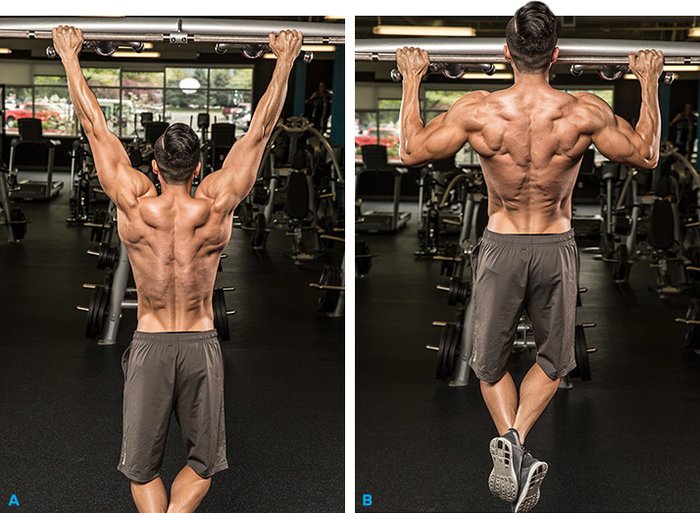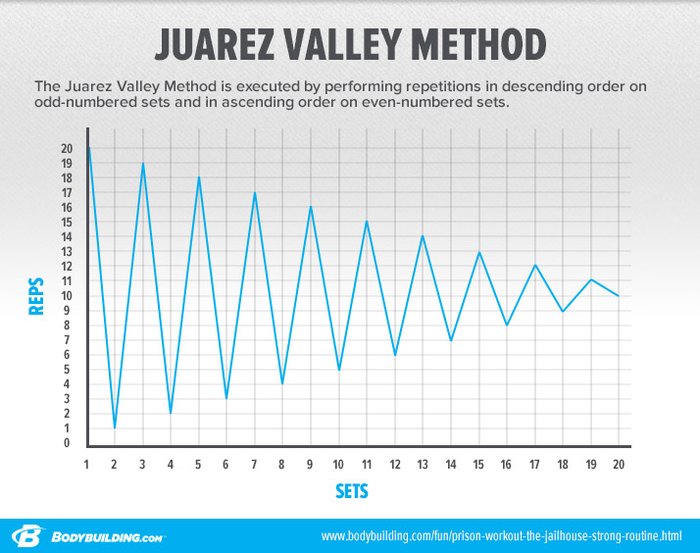As any die-hard gym rat will tell you, work sometimes puts a damper on your scheduled sweat session. There are times when you're on business trips and away from the comforts of home. Eating clean on the road can be hard enough, but when you're spending days at a corporate sales convention in a budget motel outside of Terra Haute, Indiana, with limited space, minimal time, and no access to a weight pile, you need to find a way to stay on your workout routine.
With this situation in mind, who better to look to for an example of achieving more workout results with fewer amenities than the jailhouse denizen? Through dedication, innovation, and determination, prisoners are able to make incredible strength gains without access to the latest advances in equipment and nutrition. Just think of "Iron" Mike Tyson in the mid-1990s.
So how do they do it? At the core of any prison workout are foundational bodyweight movements done in a repetitive sequence and in an imaginative array of variations. An approachable way to incorporate prison-style bodyweight training into your workout program is through a series of 30-minute workouts in a three-day split as follows:
- Day One: Upper body (push/pull)
- Day Two: Lower body
- Day Three: Total body
- Day Four: Rest
- Repeat
1. Upper Body
Your prison upper-body workout centers on two movements: the push-up and the pull-up. First, push-ups build muscular density in what cons call their hoods (the chest) and their back arms (the triceps). Push-ups are not only beneficial for building muscular endurance and explosive power, but they can be done in a number of variations that allow you to hit your muscles from unusual angles. Variation is what sparks growth and helps you break through longstanding performance plateaus.

Pull-Up
Second, pull-ups offer a means to build the upper back into the V-shaped tapered look that fills out prison denim as well as the corporate blazer. An additional benefit of pull-ups is that they can be completed in a number of ways, each of which targets different muscles while offering a means to stave off mental fatigue. The chin-up variation—palms facing toward you—offers T-shirt-popping biceps training. Opposite grip pull-ups—one palm facing away and one palm facing toward you—mimic the hand position most commonly found in grappling or wrestling. This hybrid between the pull-up and chin-up has functional applicability to the wrestling body lock and clinch.
No pull-up bar? No problem. Use the top of your door. When travelling, a towel under an open door serves to produce a stable base for wrapping your fingers around the top of the door and getting in some pull-ups.
Workout Pyramid of Pulls
Perhaps the most readily accessible routine for pull-ups is the pyramid program. This program was used by former Spetsnaz (Soviet Special Forces) trainer Pavel Tsatsouline to quickly increase pull-up repetition capabilities.
Start at 1 rep, progress to 2, then 3, and continue until your reach 10 and you descend back down the pyramid to 1. The completion of this pyramid totals 100 pull-ups.
If this is too audacious for you, start at a pyramid of 4 or 5 reps, but start today. The pyramid can be done in supersets with the Deck of Pain (see below), or it can be completed after. In either case, you should finish the pull-ups within 15 minutes. You can do the traditional pull-up or switch form at your discretion.
Workout Deck of Pain
Got a deck of cards? Make them work for you. The deck of pain is a way to use the slick gambler's favorite tool for more than just five card stud.
Take a 52-card deck and shuffle the cards so you have no idea what card will come up next. Flip the first card and do however many push-ups the card says. For face cards—jack, queen, and king—do 10 push-ups. When you turn up an ace, do 11 push-ups. Once completed, you will have done 380 push-ups. For the Deck of Pain neophyte, shoot to complete the deck in less than 15 minutes.

Push-Up
2. Lower Body
When cons don't have access to the iron (as is the case in the California penal system), they train legs by putting a fellow inmate on their shoulders while doing squats. In addition, bodyweight squats—aka "prisoner squats"—are done with reps reaching the hundreds and, in some instances, the thousands.
The strength benefits of bodyweight squats were evident when a bigger and broader Mike Tyson came back to boxing after his three-year stint in a correctional facility. Along with T-shirt-popping biceps and shoulders that could take out doorjambs, Tyson's thighs filled out his trademark black trunks like never before.
Lunges are another popular option because they target the quads and glutes without requiring much space. As a functional exercise, lunges are hard to beat because they mimic the movement of a grappling takedown. They're also similar to a boxer lowering his body to evade punches or to generate power in his punches.

Bodyweight Squat
To develop his tree trunks, it is said that Tyson's leg workout during his time behind bars was the following:
Workout Tyson Squat Workout
Start with 10 cards. Line them up 2-4 inches apart. Do one bodyweight squat. Squat down again to place the first card on top of the second card. After, perform one squat for each card in the growing pile. In this case, two cards in the pile equals two reps. Squat down to pick up the third card. Add it to the pile, then perform three squat reps. Proceed with this pattern until you've moved through all ten cards in the line. At that point, you will have completed 100 squats. You can add cards as your strength and endurance increase. Do this twice, preferably without resting between squat sequences.
Workout Jailhouse Method Reverse Pyramid for Lunges
The Jailhouse Method is a descending order of repetitions. The Jailhouse 20 is a total of 210 repetitions, where set 1 is performed with 20 repetitions, set 2 is 19 repetitions, set 3 is 18 repetitions, set 4 is 17, and so on. Each set descends by one repetition. A Jailhouse 30 is a total of 465 repetitions. After each set is performed, walk 16 feet: 8 feet across your cell—or motel room, in this case—and 8 feet back. This serves as your interval rest period. The lower-body workout is designed to take 30 minutes—see how much time you have left after doing the Tyson Squats and plan accordingly.

"After each set is performed, walk 16 feet: 8 feet across your cell—or motel room, in this case—and 8 feet back. This serves as your interval rest period."
3. Total Body
One of the most popular bodyweight movements inside any prison is the burpee—a functional strength-endurance movement that trains the entire body. Burpees have direct transference to the realities of unarmed combat because they mimic the explosive process of transitioning between fighting on your feet and on the ground. Burpees are performed in a number of variations, with some offering increased upper-body training and others offering explosive lower-body strength benefits.
In addition to being a great full-body workout that adheres to the jailhouse tradition of bodyweight movements, the benefits of increased movement explosivity range from faster reflexes in a self-preservation scenario to clearing out of your office cubicle before the crowds ruin your happy hour.
Our prisoner burpee workout is done in Juarez Valley-style with 5-count jumping burpees. Follow this simple guide to perform one:
- Count 1 From a standing position, drop into a squat position and place your hands on the ground.
- Count 2 In one rapid motion, push your feet straight back into a plank (push-up position).
- Count 3 In one quick movement, again return to the squat position.
- Count 4 Jump as high as possible
- Count 5 Return to the starting position.
No celebrity trainer invented the Juarez Valley Method—it's straight out of Cereso Prison in Juarez.
Workout Juarez Valley Method
Unlike the Jailhouse Method, the Juarez Valley Method is, well, like a valley. Repetitions are performed in descending order on all odd-numbered sets, but repetitions are performed in ascending order on even-numbered sets. In the middle they meet! A Juarez Valley 20 is performed liked this:

With repetitions performed in descending order on odd-numbered sets, but in ascending order on even-numbered sets, it is easy to see how the Juarez Valley Method got its name.
The complaint about the Jailhouse Method is that the difficulty in the beginning of the workout can be overwhelming, and that the ease at the end of the workout is not challenging. In contrast, the Juarez Valley Method keeps a steady level of difficulty throughout the workout.
To track your progress, keep these benchmarks in mind: Below 24 minutes = good, below 20 minutes = excellent, below 15 minutes = you own the yard and the warden will call you "sir."
Final Thoughts
Regardless of any road blocks to the pig iron, the basics of training are simple: Where there's a will, there's a way. It all comes down to how hard you push yourself. Each of these prison workouts should take 30 minutes or less. If these routines are beyond your current levels, keep track of how far you make it through the workout. The next time, push yourself through one more set. This way you ensure progress. It's true that Rome wasn't built in a day, but it would never have been built at all without laying the first foundational brick.
If you have nothing but time your hands, do these workouts twice a day. If they're too easy, try more advanced variations of each exercise. Even for a bodyweight pro, a Tyson pistol squat workout is no walk in the park. For the seasoned bodybuilder or strength athlete who needs a change in his or her routine, these workouts could add a whole new level of dimension.

